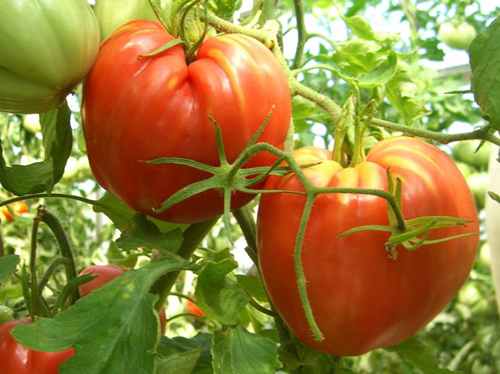Tomato variety Cardinal
In every vegetable garden, among pickled tomatoes and suitable for whole-fruit canning, there must be a salad variety. These include the famous Cardinal. An application for its registration in 1997 was submitted by Gisok, LLC. In 1998, the variety was included in the State Register of Plants of the Russian Federation with admission to cultivation in all regions of Russia. The originator is Gisok-Agro LLC. In industrial production, the tomato is not used, but it is perfect for garden plots, home gardens and small farms. In the southern regions, it is possible to grow in the open field, in cool ones - under film shelters, in unheated and heated greenhouses. The Cardinal is not a hybrid.

Description
The plant is semi-determinate, tall. The height in the open field reaches 1 meter, in the closed field - 150 or 180 cm. The growth of the central shoot stops after the laying of 8 or 12 peduncles. Weak branching, weak or moderate foliage. Leaves are normal in shape and size, light green, slightly wrinkled surface. Yellow flowers are collected in a simple inflorescence with a loose structure. The first inflorescence appears above 8 - 9 leaves, then it is laid every 1 - 2 leaves. In each hand of the Cardinal, 5 - 8 ovaries are formed. Hall of inflorescences is weak.
The fruits are large, heart-shaped (which resembles a bull's heart), with a moderately pronounced ribbing, the apex is often with a spout. According to the State Register of Varieties of the Russian Federation, the average weight of a tomato is 442 grams. According to other sources - from 250 to 600 grams. According to reviews, the less fruits are left on the plant, the larger they ripen. When unripe, the tomato is light green, with a dark spot at the peduncle. The ripe fruit acquires a pink color with a raspberry tinge, the stain disappears. The skin is not thick, slightly shiny. The flesh is very fleshy, thick-walled, sugary. There are very few seeds, there are only 4 seed chambers, they are small, located closer to the walls of the fruit. For these qualities, Cardinal can be attributed to the famous beef tomatoes, which are distinguished by the fleshiness of the fruit. The taste is sweet, therefore the taste is assessed as excellent.

Characteristics
- The variety is mid-season. The period from germination to maturation takes 110 to 115 days;
- the harvesting period starts in July and ends in September;
- yield, according to the State Register, is good - up to 7.2 - 8.4 kg per 1 square meter. Other sources indicate up to 4 - 5 kg per plant;
- the output of commercial products is high - up to 97%;
- in the open field, the tomato acclimatizes well and tolerates cold snaps;
- despite belonging to varietal plants, Cardinal is very rarely affected by the main diseases and pests of the nightshade. Although some gardeners on the forums complained about the defeat of late blight, by the way, there are very few such reviews;
- despite the thin skin, the crop tolerates transportation without losing its attractiveness, it is even possible to store tomatoes at the stage of technical ripeness;
- the way of using the fruits is salad. A sweet and fleshy tomato is always used as a soloist in vegetable salads. If desired, you can make juice or sauce from it. The variety is not suitable for canning.
Agrotechnics
Cardinal is grown exclusively in seedlings, especially in regions with a short summer period. Sowing for seedlings is carried out in such a way that when planting in a permanent place, the seedlings are about 60 - 65 days old. Planting scheme: between bushes in a row - 40 cm, row spacing - 70 cm.Planting density: when grown in 1 stem, up to 4 plants per 1 square meter can be planted, when formed in 2 stems - 3 specimens per the same area, although many gardeners say that the culture can withstand more compacted plantings. After planting, the bushes are tied up on a support or trellis; it is also necessary to carry out timely pinching. In cool regions, it makes sense to form a tomato into 1 stem, leaving no more than 5 brushes on it, so that the plant has the opportunity to give the entire crop in a short growing season. In the southern regions and in the greenhouse, you can grow a variety with 2 stems. Watering is carried out as needed, making sure that the soil is moderately moist. Top dressing is required. The best option is universal mineral fertilizers. To prevent the plant from being affected by late blight, fungicides or folk remedies, for example, whey, can be used.
Do not confuse the hero of our article with varieties that have similar names - Cardinal Mazarin, K. red, K. Richelieu. Often, gardeners who buy such seeds in the hope of a good harvest are disappointed. This is due to the fact that some unscrupulous fly-by-night firms sell the usual re-grading under the loud name of already well-known varieties. Therefore, before purchasing seed, make sure that the originator or at least a reputable seed company sells it.
Cardinal is appreciated for its highly marketable and very tasty fruits for salad use. With simple agricultural technology, a fairly decent harvest can be removed from one bush. In addition, you can harvest the seeds yourself for further breeding. The disadvantage of this tomato can be considered the need for tying and timely pinching.








